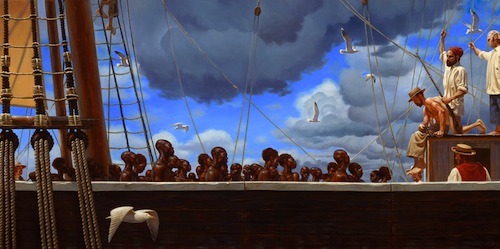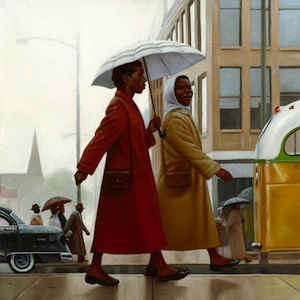Three years later the dividend of that trust is Heart and Soul: The Story of American and African Americans(HarperCollins/Balzer + Bray, Aug.) which PW, in a starred review, called "a tremendous achievement." In the voice of a woman who's seen it all, Nelson takes readers from pre-Revolutionary War America all the way up to the election of President Barack Obama, recording the tragedies and the triumphs.
"It's ironic," Nelson writes in his author's note. "History was not at all my favorite subject in school." And yet much of the acclaim that has come Nelson's way stems from his ability to powerfully illuminate the troubled existence of blacks in America—the perilous journey out of slavery in Henry's Freedom Box, written by Ellen Levine; the soul-stirring biography of Harriet Tubman in Carol Boston Weatherford's Moses; the indignities suffered by the men who played baseball just as well as white men but were paid a pittance because of the color of their skin in We Are the Ship. "I had been telling the African-American story all along but I hadn't tried to tell it all in one place," Nelson says.
Before We Are the Ship, he hadn't written the stories himself either. The success of that book, which won the Coretta Scott King Author Award and the Robert F. Seibert Medal (for nonfiction), gave him the confidence to try again, albeit on a much broader canvas. When Bray gave the green light, however, he remembers thinking, "Uh-oh. This is a big fine mess I have gotten myself into." Nelson confided his fears to a friend who confirmed them. "He said to me, ‘There's no way you can do that! It's too big! Do you know how many books you're going to have to read?' He was just saying what I had already said to myself."
Nelson was determined, however. "Someone once asked me what my work was about and I said, ‘I am in hot pursuit of the truth.' History is a way to look for it. You get a general swath of it in school but that wasn't enough for me. I wanted to know the real story. And I had to begin with me. Find out more about my family, how they contributed not only to my life but to the life of our country."
Nelson persevered through several attempts that were "not good," he says now. He showed his draft to his agent, Steven Malk at Writers House, "who said to me, ‘Well. There's some good things here.' "Nelson took his struggle to Ann Dieble, the designer who had worked with him on We Are the Ship, which is narrated by a (fictional) old-time veteran ballplayer. In Heart and Soul he had tried a similar device—but the voice was less a person than "an ancient spirit from across the ocean." According to Nelson, Dieble told him, "Make it a woman. Don't go so far back in time."
"When she said that, I knew it was right. I immediately thought of my grandmother," Nelson says. His grandmother, Verlee Gunter-Moore, had inspired him before. A grocery store owner in Atlantic City, N.J., Gunter-Moore had muscular forearms from ripping up boxes by hand and shelving products. Nelson had used her as a model for Moses, as a "cuter version" of the powerfully built Harriet Tubman.
He also relied on family for research, interviewing siblings, his parents, aunts and uncles, his grandmother. He remembered a story his Aunt Elaine had once told him about the last member of their family to have been a slave. He prohibited the serving of black-eyed peas on New Year's Day, a Southern tradition thought to bring good luck, because when he was a boy, the black-eyed peas were poured into a horse trough on New Year's Day for the slaves on the plantation to eat like animals. "After he was freed, he vowed neither he nor any of his families would ever eat black-eyed peas on New Year's Day again," Nelson says.
...
"I think his work is more emotionally charged than anybody else's I've come across because he feels these subjects completely," Bray says. "So many of his portraits are composed so that the subject is looking directly at you. You feel so drawn in, like he's gotten inside these people. I think the reason for that is Kadir has not only passion for the subjects but compassion. He is moved by these stories and wants other people to feel the same."
Yes, Nelson says, he could choose lighter or easier subjects at this point in his career, but he feels drawn to take on subjects worthy of his considerable—and he would humbly say—natural-born talent. His next project is a picture-book biography of Nelson Mandela for Katherine Tegen Books at HarperCollins, for fall 2012.
"Some people don't discover what their gift is for a long time but mine was apparent from a very young age and I am cognizant of that and respectful and grateful," Nelson says. "It took a long time for me to figure out not to get in the way of it, that it's not really mine, it just comes through me. The only important thing about the work now is that I do whatever it is that is on my heart."
http://www.publishersweekly.com/pw/by-topic/childrens/childrens-authors/article/48018-kadir-nelson-the-accidental-historian.html?utm_source=Publishers+Weekly%27s+Children%27s+Bookshelf&utm_campaign=67c2ccea69-UA-15906914-1&utm_medium=email



















No comments:
Post a Comment